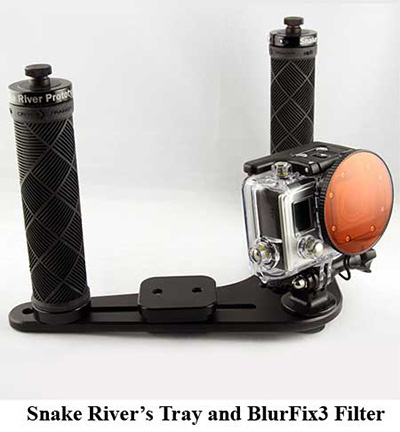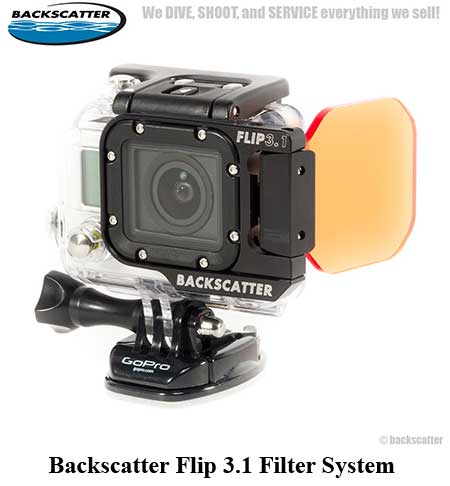Get the Most from Your GoPro UnderwaterContents of this Issue: Arenui, Alor Archipelago, Indonesia A Major Mask Recall Due to Shattering Glass Undercurrent Can Sure Use Your Help Fantasy Island, Roatan, Honduras Latest Shark Research: Shields Are Effective, Bubble Curtains Arenít Aqua Lung Facing a Class-Action Lawsuit What on Earth Were They Thinking? Get the Most from Your GoPro Underwater Fugitive Dive Operators Found, Then Charged with Manslaughter Lessons Learned from Dead Divers Whatís Going on with the Aggressor Fleet? Wearables Come to the Dive Industry Editorial Office: Ben Davison Publisher and Editor Undercurrent 3020 Bridgeway, Suite 102 Sausalito, CA 94965 the accessories that guarantee divers will get better shots from the August, 2015 issue of Undercurrent
The GoPro Hero range of action cameras is a marvelous addition to your dive gear bag. I first wrote about GoPro and its Hero3 model in the November 2013 issue of Undercurrent, but in its latest Hero 4 incarnation with its watertight housings, these little POV cameras have an application for almost any activity, especially risky activities that might destroy a more conventional camera. No wonder GoPros proved to be the most popular Christmas present of 2014.
The standard watertight housing that it comes with is good to 130- feet deep. If you want to go deeper, there's a tougher 200-feet-rated GoPro "diving housing" available. Independent manufacturers also make GoPro housings. For those who want to take their GoPro really deep, there is the aluminum i-Pix GP-H3 housing designed to be used up to 500 feet deep. ( U.S. dealers are listed at http://i-divesite.com/product_pix.html# ) A wide variety of accessories will allow you to mount your GoPro Hero 4 almost anywhere. It's simple to bolt a Hero 4 to a bike or fix it to a skiing helmet and get interesting shots, but underwater, the characteristics of light conspire to make it more difficult to get good footage. It matters little whether you use a Hero 4 or a Red Epic camera that costs thousands of dollars. The physics of light and water remain the same. Hold-Steady Accessories If your material is going to be watchable, you need to keep your camera steady in water that may be moving. I recommend some sort of handle -- one that can be made neutrally buoyant will be best. You neither want your precious GoPro Hero 4 to float off nor to drop to great depths should you let go of it. SP Gadgets makes a Dive Buoy grip that you can adjust so the entire rig will be neutrally buoyant ( $30; www.sp-gadgets.com ). If you want to combine your GoPro with underwater lights, a tray with mounting arms upon which you can fix a couple of small video lights will come in useful. However, note where your hands end up on the grips or the handles in relation to the camera lens; you don't want to see your knuckles in every shot. You need the camera mounted well forward from where you hold it. Snake River Prototyping makes a V-shaped Tray Stabilizer for the GoPro that positions the hands well back from the line-of-sight and can accept lamps screwed in to the grips' top ( $130, www.snakeriverprototyping.com ). GoPole makes several telescopic extending poles that allow you to record images from more than arm's length ( $23 to $55; www.gopole.com ). Silver Screen or Black Screen?
So what does the more expensive Black Edition offer over its Silver sibling? Simply, light sensitivity and frame-rate. The Black Edition will run at 120 frames per second in 1080p high-definition video, meaning it can smooth out the action of faster moving subjects. It will function better in gloomier conditions, and it will even shoot 4k video. It's simply twice as good as last year's Hero 3+ Black. For divers, an economically priced add-on LCD screen is available for the Black Edition. It plugs into the camera, and it comes with the fatter watertight back door for the housing to accommodate it. It also functions as a touch-screen to let you easily set up the options in each camera's menu. Filters and Lights Water absorbs light but does so selectively. The warmer wavelengths of light, the reds and the yellows, are filtered out as you go deeper, so everything starts to look very blue. You can make the most of the red, yellow, and green light that penetrates the water in the first 50 feet by filtering out some of the blue. Alas, despite its Protune software that gives an element of color control, the GoPro does not offer much in the way of white balancing, so filters are the only real solution to the rather bluelooking footage otherwise recorded. Snake River Prototyping's BlurFix3+ 55 color correcting dome filter works for both Hero 3+ and Hero 4 ( $40; www.snakeriverprototyping.com ). Although a flat red filter will work with the GoPro Hero 4, a domed filter will be more effective over the width of the image, and sharpness won't suffer at the edges. However, if you carry a set of filters suitable for good color rendition at different depths, you'll wonder what to do with the ones you're not using. You can get a little rig that allows you to mount two different filters at the same time, and flip either one or both out of the way when you don't need them. The Backscatter Flip 3.1 filter system combo allows you to flip one of two appropriate color correction filters in front of the lens, according to ambient depth, without actually detaching them from the camera. It comes with a choice of three filters, and there is also an option of a macro lens. ( starting at $69; www.backscatter.com ) As with any camera, if you want decent color when you go deeper, you will need to take some white light with you in the form of lamps. Still cameras can use flash, but for live action, you need a constant source of light. Although a GoPro will shoot stills, it does not synchronize with a strobe light, so a bright lamp that gives a good color light is required. (A dive light won't provide enough light.) In addition, the GoPro Hero 4 will try to look into the shadows, leaving the lit parts burned out. You need video lights with broad, even beams that can be positioned behind the camera and away from the optical axis of the lens to avoid backscatter (the lighting up of detritus and plankton in the water). You can combine video lights with the GoPro in a similar way to the mounting of strobe lights on still cameras. Think in terms of two video lights with an output of at least 1,000 lumens each, and check that their output color is not too blue. A pair of Big Blue AL1000XWP lamps offer 1000 lumens output each with sufficiently even light coverage to suit the GoPro sells at a reasonable price ( $165, www.bigbluedivelights.com ). Additional Extras What else do you need? A spare battery and charger will come in useful. That battery can be charging while you are underwater with your GoPro, either connected to the dual battery charger, the USB socket of a computer or anywhere you normally charge your iPhone. Depending on framerate and LCD use, the battery is good for 40 to 90 minutes, which means a fully charged battery for each dive. The GoPro uses Micro SD memory cards, which come in a variety of capacities. If you are using a Hero 4 Black Edition, be sure to use memory cards with a suitably fast write-speed. You can download directly from the camera to a computer, or use an SD converter and download directly via the SD slot on your laptop. I suppose the GoPro's Achilles heel is that it's extremely wide-angle lens is positioned behind the flat port of the housing. Thanks to the refraction of light as it passes from a dense medium (the water) to a less dense medium (the air inside the housing), this angle-of-view is very much narrowed. Not only that, the recorded footage tends to look not-so-sharp toward the edges of the picture. The secret of clear, sharp results underwater is to reduce the amount of water between the camera lens and the subject by getting as close to it as possible. A super-wide-angle lens calibrated for in-water use allows you to restore the image size, and get a larger subject properly framed. The Japanese manufacturer Inon has come up with a solution -- the SD Mount Cage can supply a mounting frame for its semi-fisheye conversion lens and/or wide close-up lens with a dome port to fit on the front of the GoPro camera. It's incredibly effective, but the mount and lens's price more than doubles the cost of your original outlay ( $480; www.inon.jp/products/gopro/top.html ). Finally, remember when you shoot footage with a GoPro, you are only making the bricks for the final architecture of your production. Downloading the free editing software from GoPro's website is the first step toward assembling a completed underwater film or slideshow that will keep your audience's attention. As epic film director David Lean said, "It's all in the editing." John Bantin is the former technical editor of DIVER magazine in the United Kingdom. For 20 years, he used and reviewed virtually every piece of equipment available in the U.K. and the U.S., and made around 300 dives per year for that purpose. He is also a professional underwater photographer, and most recently the author of Amazing Diving Stories, available at www.undercurrent.org |

I want to get all the stories! Tell me how I can become an Undercurrent Online Member and get online access to all the articles of Undercurrent as well as thousands of first hand reports on dive operations world-wide
| Home | Online Members Area | My Account |
Login
|
Join
|
| Travel Index |
Dive Resort & Liveaboard Reviews
|
Featured Reports
|
Recent
Issues
|
Back Issues
|
|
Dive Gear
Index
|
Health/Safety Index
|
Environment & Misc.
Index
|
Seasonal Planner
|
Blogs
|
Free Articles
|
Book Picks
|
News
|
|
Special Offers
|
RSS
|
FAQ
|
About Us
|
Contact Us
|
Links
|
3020 Bridgeway, Ste 102, Sausalito, Ca 94965
All rights reserved.

 However, I've watched divers who have made the trip of
their lifetimes to remote locations like Truk Lagoon use their
GoPro cameras after opening them straight out of the box. I fear
they will inevitably be disappointed with the results. Here's my
advice on how you can get professional-looking results when
taking your GoPro underwater.
However, I've watched divers who have made the trip of
their lifetimes to remote locations like Truk Lagoon use their
GoPro cameras after opening them straight out of the box. I fear
they will inevitably be disappointed with the results. Here's my
advice on how you can get professional-looking results when
taking your GoPro underwater. If you are trying some daredevil activity, you'll be happy with whatever you record. Underwater,
however, you'll want to be more selective, especially if you are using an ancillary macro lens for recording small subjects. An LCD screen that shows exactly what
the camera sees is essential. The Silver Edition of the GoPro Hero
4 comes equipped with it, but the much higher quality Hero 4
Black Edition does not.
If you are trying some daredevil activity, you'll be happy with whatever you record. Underwater,
however, you'll want to be more selective, especially if you are using an ancillary macro lens for recording small subjects. An LCD screen that shows exactly what
the camera sees is essential. The Silver Edition of the GoPro Hero
4 comes equipped with it, but the much higher quality Hero 4
Black Edition does not.